No products in the cart.
Close Calls
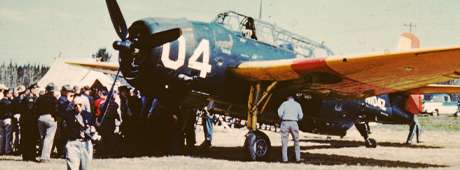
On the Forest Fire Crew
By Ray Brooks
Our vintage bubble-canopy, three-seater helicopter was poised for takeoff from the summit of 8,400-foot Dollarhide Mountain west of Ketchum. It was almost dark on this day in 1969 and a violent thunderstorm was in progress—conditions were hardly optimal for flying an old ‘copter off a high pass. Danny, our Vietnam vet pilot, radioed the Sawtooth National Forest’s fire dispatch that he was shutting down the bird for the night and we would fly back to Hailey at first light.
Our fire dispatcher, also a Vietnam vet, replied that he needed the ‘copter fueled and ready for fire fighting in Hailey at first light. “If you’re not man enough to fly back to Hailey tonight,” he said, “I’ll find someone who is.”
Danny, who had just been discharged from the Army after flying medical evacuation helicopters in the war, had a wife and baby waiting for him in a seedy apartment in Hailey. He took the dispatcher’s threat seriously. He sighed deeply, told me and my fellow crewman Kenny to buckle up, and started the machine. At age nineteen, my usual certainty that my life would continue suddenly sank. I was particularly bothered by the gasoline that had soaked into my shirt when the chainsaw gas can I had been carrying in my fire pack leaked. Danny warmed up the engine to the point where our fragile craft shook from the prop-wash. He applied more throttle and then skimmed above the ground downhill through scattered lodgepole pines to gain enough speed to climb above the trees. Except for the occasional nearby flash of lightning, the rest of the flight was fairly peaceful. Danny said it was a lot like night-flying in Vietnam, except no one was shooting at us.
What I didn’t know until later was he had redlined both the engine’s RPM and its oil pressure to keep us high enough to fly twenty miles back to Hailey over 9,500-foot ridges we couldn’t see in the darkness. The airport at Hailey did not have a control tower or lights at night back then. Danny brought us in low over the town’s lights and headed for the small Forest Service installation on the airport’s west side. When he turned on his landing lights, they showed we were right up on a large cottonwood tree, and he quickly veered to avoid it. He made a safe landing and we refueled the ‘copter from a fifty-gallon barrel of aviation fuel. The three of us stopped for a six-pack of beer on the way to his apartment and, after greeting his wife, we sat on his front steps and toasted the achievement of cheating death.
It had been a very big day for me. That morning, the alarm clock had awakened me at 5:00. The previous night, thunderstorms had been predicted over the Wood River Valley and I was assigned to be a smoke-watcher on an early morning airplane flight out of Hailey. There were few clouds and we enjoyed calm skies during our flight up the east side of the Wood River and Salmon River valleys to Stanley, and then we flew back south over the Sawtooth Range and the Smoky Mountains to Hailey. Neither the pilot nor I saw any fire smoke but we flew directly over two small lightning-caused fires on the western slopes of Dollarhide Mountain.
After the plane landed back in Hailey, I had lunch at the ranger station and was told I would be riding in a helicopter to spot new lightning-caused fires. Within minutes, we were flying northwest. Danny made a nice landing atop Dollarhide Summit in early afternoon and we were met by a Forest Service pickup, which hauled Kenny and me down the twisty road in case we could help a fire crew from a nearby ranger station on two small lightning-caused spot fires that I had failed to see on my earlier flight. Our help was not really needed, as the fires were already well-controlled but we worked for several hours to put out every remaining ember. We then were driven back to our ‘copter for what became our lightning-storm flight home.
Throughout my college years, I had a well-paying summer job with the soon-to-be-closed Hailey Forest Service District of the Sawtooth National Forest. My family lived nearby, so I also had free board and room at home. For my first two summers, 1968 and 1969, I was part of a four-man “helitack” fire crew based in Hailey. The first summer was very wet. After a training week, we mostly built fence and when it was too wet to do that, we refinished the district ranger’s desk. The second summer was normal weather and we had a lot of small spot fires from lightning. There were the usual close calls but, as I say, I was nineteen and indestructible.
The second summer I worked helitack, sixteen helicopters were assigned to our Forest Service region, which included southern and central Idaho, western Wyoming, northern Utah, and northern Nevada. During that summer, twelve of those aircraft had accidents or mechanical failures and crashed. The following summer, Danny and his mechanic took our ‘copter for a test flight after maintenance. A couple thousand feet above Hailey, the engine died, and Danny autorotated the ‘copter, flying it by the action of air moving through the main rotor. He made a hard landing in a vacant lot. As he and the mechanic jumped out of the smoking wreck and ran for safety, it exploded behind them.
Helicopter like the ones used in late 1960s in the Sawtooths. Ray Brooks.
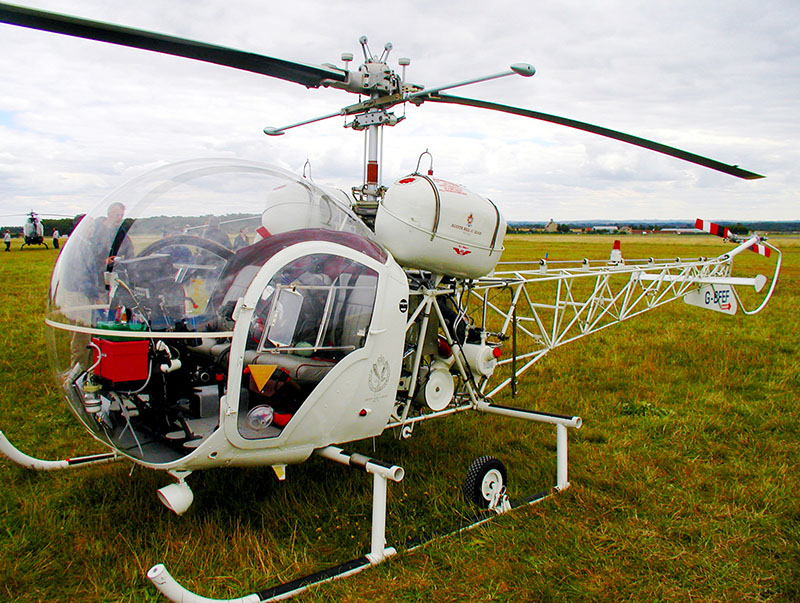
WWII Forest Service Avenger, similar to those used in Idaho in 1960s. USFS photo.
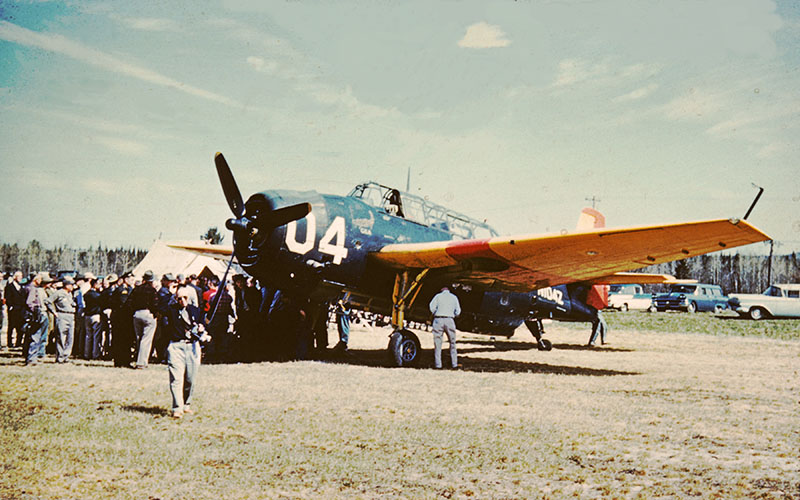
Upper Little Wood River. Ray Brooks.
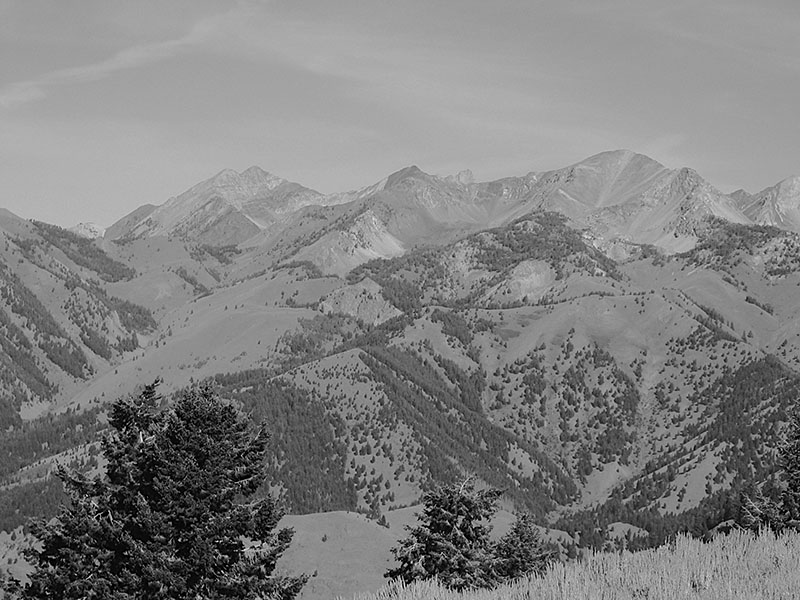
Garfield Forest Service station, 2019. Ray Brooks.
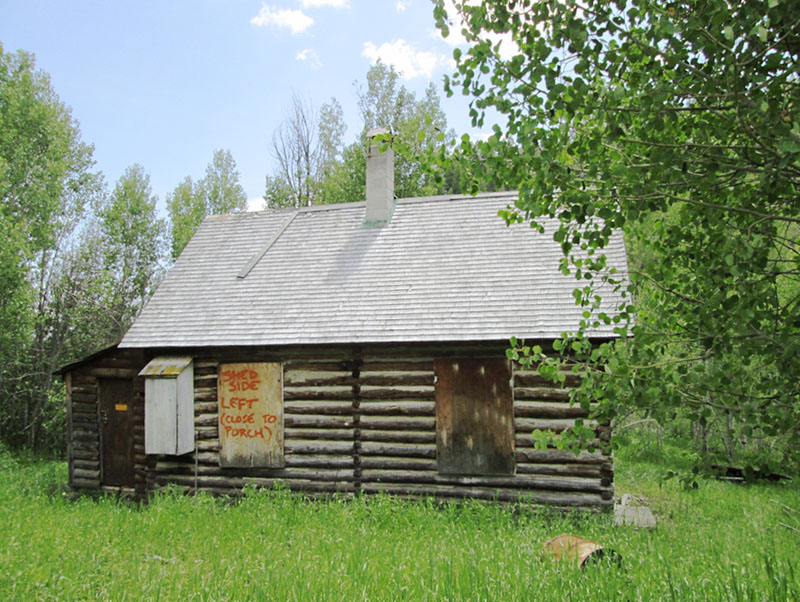
Hailey Forest Service station. USFS photo.
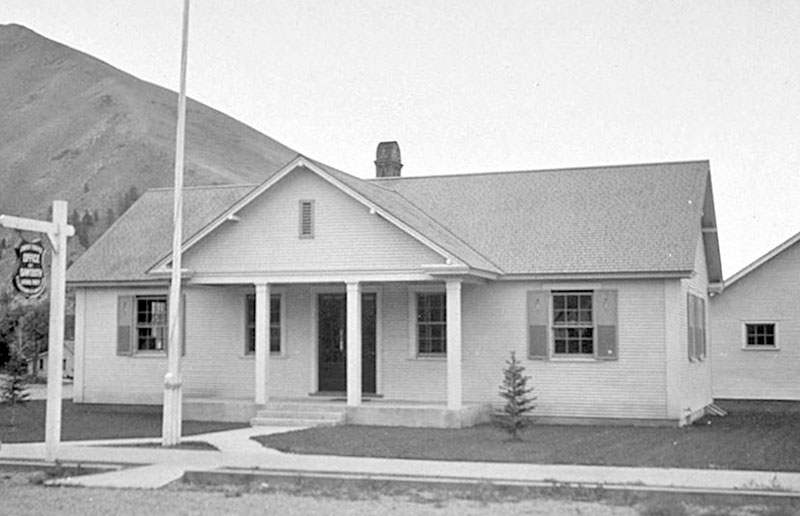
Dollarhide Mountain summit, 2021. Ray Brooks.
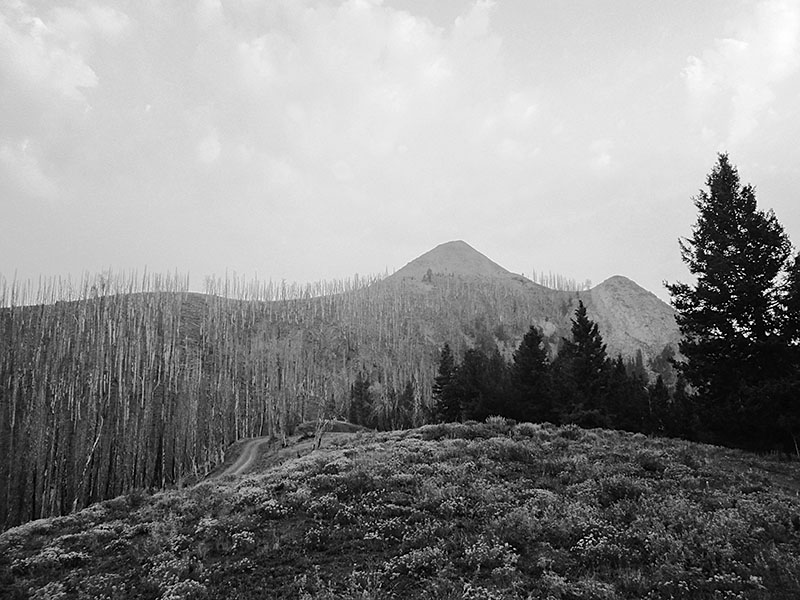
Of course, fire crews are now much safer than they were in the 1960s, when the Forest Service had a collective horror of forest fires that dated back to the legendary 1910 Big Burn, which scorched much of northern Idaho and northwestern Montana (see “Racing the Flames,” IDAHO magazine, April 2019). It burned several good-sized towns and killed seventy-eight firefighters. Memories such as that one contributed to a mandate that every forest fire must be fought immediately with the maximum available force.
On another trip, Danny flew Bob Allred and me to a ridge high above the South Fork Boise River, north of Fairfield. From miles away we could see a tall, lightning-struck Douglas fir burning, since there were no other nearby trees. There was no flat spot to land but Danny guided the ‘copter to a somewhat-steady hover just over a sagebrush that gave him a visual reference point to hold the aircraft as Bob and I high-stepped out. We grabbed our fire-fighting tools and a large radio from a wire basket on the side of the hovering ‘copter. We trotted away from the swaying aircraft with our heads down and Danny flew back to Hailey. Last summer, incidentally, a Forest Service helitack professional vehemently assured me that our method of landing is no longer used.
The fire was pretty simple to put out. Bob cut down the tree with our chainsaw and we chopped away the burning parts with our Pulaski ax and buried them. The fire was out in several hours, but policy dictated that we watch it overnight before declaring it dead. It was nearly dark and we decided to spend the warm summer night nearby. We figured Danny could pick us up the next morning. Bob used our radio to call fire dispatch and the same efficiency-obsessed man answered who had spoken to Danny when we flew off Dollarhide. He said we and the ‘copter all had to be ready to go the next morning for more possible fires. He told us to walk off the mountain. A vehicle from the nearby Big Smoky Guard Station would meet us and take us to a bunkhouse for the night.
By the time Bob and I had consumed a cold C-ration dinner and packed up our gear for the hike of two thousand vertical feet, it was nearly dark. I carried our bulky twenty-pound radio in one hand and our Pulaski in the other. Bob had our chainsaw and a shovel, and we were both wearing thirty-pound fire packs. Fortunately, we both had battery-powered headlamps that cast a lot of light, when they worked.
The northern slope we descended was mostly open grass and timber with an occasional short cliff that we skirted. We stayed in radio contact and soon saw the headlights of a pickup. The driver spotted our lights and positioned his vehicle so we knew what to head for. It was a garden-variety miserable hike until I missed a four-foot cliff and tumbled over it. Luckily, I landed uninjured on my rear but the radio and my headlamp no longer worked. We shared Bob’s light until at last we reached the foot of the mountain, fought our way through some willows, waded the river, and greeted our patient driver. By then it was 4:00 a.m.
Another time, Danny flew our crew boss Kelly and me to a small creek near Soldier Mountain northwest of Fairfield. A fair amount of smoke was coming from the creek bottom, below a dense eighty-acre stand of trees. Danny made an easy landing on a sagebrush ridge just north of that stand, about one-quarter mile uphill from the smoke’s source. We unloaded our gear and Danny took off to fetch more firefighters. Before we could work our way down to the fire, it suddenly burst to life and within seconds turned into an inferno that roared up through the trees. It seemed prudent to run the other way. After the fire scorched through the eighty acres of trees, all that remained to burn was scattered sage and grass, and it simply stopped.
Kelly and I built a fire line a safe distance from the trees. When Forest Service workers arrived, we mopped up after the now-quiet fire and were back in Hailey by dark.
Our helitack crew shared responsibility for the Forest Service fire retardant mixer at Hailey’s airport. The mixer resembled a room-sized cement mixer and had a staircase on one side, which we climbed up with heavy bags of retardant to mix with water. In the late 1960s, the fire retardant was delivered to fires by huge single-engine WWII surplus TBM Avenger torpedo bombers. This had been the largest single-engine propeller-driven airplane to operate from an aircraft carrier. During fire-fighting operations, each Avenger held up to six hundred gallons of retardant. The planes had a huge radial engine that vibrated the air and seemed to shake the ground.
For the summers of 1970 and 1971, I transferred from helitack to a three-man Hailey District crew, on which I had a more varied work life of cleaning campgrounds, planting trees, killing excess trees, building fence, and fighting only the occasional fire. During those summers, my coworker Bob Allred and I also had what I considered to be paid vacations maintaining forest trails on horseback.
In 1970, we were in the upper Little Wood River drainage north of Carey. We were based out of the historic 1908 Garfield Ranger Station at the mouth of Garfield Canyon. No-one had stayed at the station that summer and our middle-aged crew boss, Jim Cook, showed us where the spring-fed concrete cistern for the station was located. A water line from it fed a sink in the small station. Unfortunately, when we removed the wooden cover, we discovered the cistern was full of rotting drowned mice. We took our water out of Garfield Creek after that.
Because of Forest Service budget shortages during the Vietnam War, little trail work had been done in the area for years. Bob, who had grown up on a farm, brought his own well-trained horse and the Forest Service supplied me with a big and dependable gelding named Brandy although the pack horse they also threw in was the nastiest-tempered mare I’ve ever been around.
For most of this ten-day vacation adventure, Bob led on the trail and I followed on Brandy, carrying a chainsaw on my lap. When we did a four-night trip into more remote parts of upper Little Wood River, I led our packhorse, the nasty mare. Whenever we encountered a downed tree, Bob would dismount, tie his horse to a tree or bush, grab the chainsaw, and take the tree out, while I’d stay mounted and try to keep the mare from biting or kicking my horse. Luckily, Brandy was mellow and I did have some riding experience, although when the bored mare nipped him on the rump along a narrow trail high above Little Wood River, the ensuing bucking and kicking was distressing.
We had no real problems doing day-long trail clearing trips out of Garfield Ranger Station but when we ventured into the more remote terrain of upper Little Wood River and started camping, we ran into horse problems. At our first night’s camp, Bob hobbled the front hooves of the horses. In the early evening, when we lit a fire and started working on dinner, he noticed the horses were missing. He ran down-canyon a half-mile, caught his horse, and used it to catch the Forest Service horses.
He then tied his horse to a tree near camp and hobbled both the front and back legs of the other two horses. An hour or so later, the Forest Service horses were a mile below our camp. We caught them due entirely to Bob’s efforts, and he then ran a short rope or “short snub” from the halters on the Forest Service horses to their front hobbles, so they could not raise their heads to run with the hobbles on. The mare from hell could still outrun me for a hundred yards, and then would turn to kick at me when I closed in to grab her. We eventually had to tie her to a tree.
One day in mid-August, we were clearing a side trail up Iron Mine Creek when we encountered a ten-foot-high wall of snow and broken-off trees at about 6,500 feet. It was the remnant of a huge avalanche that had come off the east side of 10,500-foot Grays Peak the previous winter. The avalanche had nearly made it to Little Wood River, a crow’s flight of about two-and-three-quarters miles. Rather than spending the rest of the week chopping through ice and chain-sawing frozen trees, we built a new trail around the avalanche. After that side-trail diversion, we continued up Little Wood River to its head, occasionally making new trail around washouts or dense masses of avalanche debris.
The only incident I recall occurred while Bob was cutting out a downed lodgepole pine that was about eighteen inches in diameter. He suddenly left the chainsaw in the log and ran, screaming, “Hornets!” He got stung a couple of times and declared it was now my turn to finish the cut. I cautiously crept toward the still-running chainsaw. It was stuck in the tree and when I gunned the engine to start the chain turning, hornets boiled out of their nest about six feet away on the log. I ran and avoided getting stung. During the next thirty minutes of effort, I managed to extract the saw without getting stung. We built a new trail around the hornets’ nest.
When we finally reached the lake basin at the head of Little Wood River, we had to turn around, because the Forest Service had quit maintaining the trail down the steep and loose west side of the ten-thousand-foot Johnstone Pass after an entire Forest Service pack string had rolled several hundred yards down it a few years earlier. No horses or people were seriously injured in that mishap but the Sawtooth Forest Supervisor was on that trip, and lessons were learned. The Forest Service pack horse we had dubbed the mare from hell had survived that Johnstone Pass incident, which maybe contributed to why she was the most crazed horse I’ve ever had to work with.
Bob and I had only a four-day working vacation pack trip during the summer of 1971. We went up one fork of Greenhorn Gulch northwest of Hailey and cleared the trail on it as far as upper Deer Creek, and then cleared trail down into the North Fork of Deer Creek and back over to another fork of Greenhorn. All went smoothly until our last day of work. While Bob was sawing out a downed tree, I dismounted and decided a dead limb that jutted into the trail from a lodgepole pine could simply be broken off. The inch-thick limb was about six feet long and limber, but after I twisted it halfway around the tree, it finally snapped into three pieces. A foot-long piece of limb flew straight into my nose, knocking me down. Of course, my nose bled wondrously, but it was not broken.
Bears were quite rare in the Wood River Valley at that time and I had only seen one in my life, which my mother immediately shot for a supplement to the winter wild meat supply for our family. However, near the end of our trip our horses started getting restless, and then a black bear ran across the trail thirty feet in front of Bob. As Bob’s horse tried to buck him off, two cubs ran between him and me. I had to drop the lead of the mare from hell to hang on with both hands as mellow old Brandy enjoyed a bucking fit, too.
Mostly, I enjoyed my summer jobs with the Forest Service. In addition to our good regular pay, fire-overtime wages added up, and we even got an extra six dollars per diem when we were on fires overnight or on pack trips. I carefully saved my wages for college and with the frugality that characterized some children of Depression-era parents, I managed to pay my college expenses with money left over for gas. I didn’t quite get my degree in four years, so I needed to go back to school for one semester in the fall of 1972. By then, the Hailey Forest District had merged with the larger Ketchum district, I took a job with them for the first part of the summer of 1972. I didn’t tell them but I planned on resigning at the end of June to go mountain climbing with my buddy Harry until school started in mid-September.
I did not enjoy working for my crew boss for the Ketchum District but I did enjoy mule-packing fence posts with Slim, the Sawtooth National Forest’s mule wrangler. He was tougher than nails and spent every winter living with a tribe in the Southwest, because they had taught him a lot, he said. In the gun rack of his old pickup, instead of a rifle Slim kept an unusual cane made out of a dried bull’s penis. I learned quite a bit about mule-packing from him, including that you don’t try to punish mules, because they hold grudges.
Slim told of his favorite mule, whom he had irritated while shoeing it. Later, he was bent over in the corral and looked up just in time to see two rear hooves striking for his head. He blocked the hooves with his arm, but the kick broke his arm in two places and rolled him across the corral.
Slim told me, “The hardest thing I ever did in my life was to get up, find a piece of two-by-four, and beat the hell out of that mule.”
During the summer of 1971, the new supervisor of the soon-to-open Sawtooth National Recreation Area shared the roomy Hailey Ranger Station with the existing district staff. Aware that I was working on a degree in forestry, he chatted me up one day about my career plans. I told him I would like to work for the Forest Service and he replied that because of Vietnam War budget cuts, there were not many career positions available. He asked what my college grade point average was, and then told me of a fellow Forestry graduate student. The man, a disabled Vietnam vet, had achieved a perfect 4.0 average in graduate courses.
My mentor leaned toward me and said, “They had to pull strings to find him a career position with the Forest Service. What do you think your chances are?”
That was the end of our conversation, as well as of my forestry career aspirations.
This content is available for purchase. Please select from available options.
Purchase Only
Purchase Only

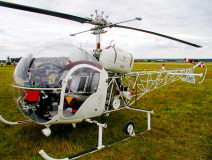
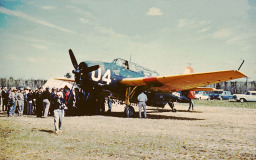
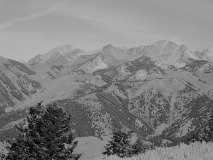
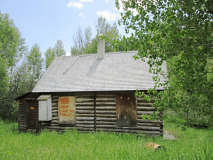
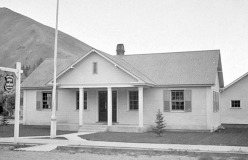
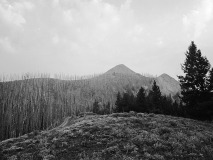
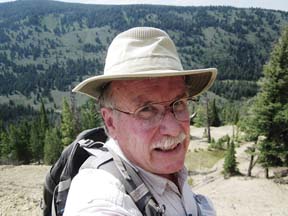
2 Responses to Close Calls
Dennis Wolfe -
at
Great stories. Reminded me of the book I’ve read by a friend, Bud Filker, who worked with the McCall Smoke Jumpers. Interesting stuff. Maybe you knew or met Bud.
Dennis Wokfe
Bruce Franks -
at
Typical Ray Brooks, well written, good stories and a fine article.